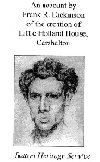
A self portrait, on the front cover of the Sutton Heritage publication [27.3kb]
The members visit to Little Holland House in April was a real joy. As indicated in the Newsdesk, we were well received by Val, and the mixture of her talk and the look round was an eye opener for those of us new to the works of Frank Dickinson.
A couple of titbits which bring the man and his times into perspective:
 |
A self portrait, on the front cover of the Sutton Heritage publication [27.3kb] |
The answer lies in the old style mutual building society. Hundreds of people in Frank's position contributed their pennies each week to the society. When the ‘pot' reached £300, there was a draw, and the luck winner scooped the lot as an interest free loan. Frank was one of the lucky ones. You can't help wondering whether, in this day and age, with the price of starter homes so great a multiple of average wages, there is not scope for a re-introduction of such schemes.
He was lucky in his wife as well. Few women, having saved long and hard for their trousseau, will give it up easily. Frank was determined to have a particularly fine slate for his roof, and the budget had run out. Florence's trousseau money came to the rescue. We do not really know who persuaded who, but there can be no doubt that the two were well matched.
The energy was also unmistakable. Work started on the site in October 1902, and the structure was finished by January 1903 - just Frank, his brother, and a labourer (to teach them how to dig - Frank and his brother were inner city boys). By March 1904 the inside was largely fitted out, and he moved in with his new bride to spend their honeymoon scrubbing and cleaning.
There is also no doubt about the strength of Frank's character. Having imbued the Arts and Crafts philosophy ‘Have nothing in your house that you do not know to be useful or believe to be beautiful' (Henry Thoreau) he spent his life trying, and largely succeeding, to combine the two, going to evening classes to learn new techniques whenever necessary.
 |
Our group in the garden of Little Holland House [80.8kb] |
 |
Our group outside Little Holland House [83.2kb] |
All credit to LB Sutton for saving the house, and continuing to make it available. As a footnote, the house still acts as accommodation for heritage service officers. It is important that such buildings are used, not just kept as sterile displays. This reflects the discussions elsewhere about combining our own lottery bid with a current business or organisation, to make the building we use as useful today as it has been in the past.
|
|
|
|